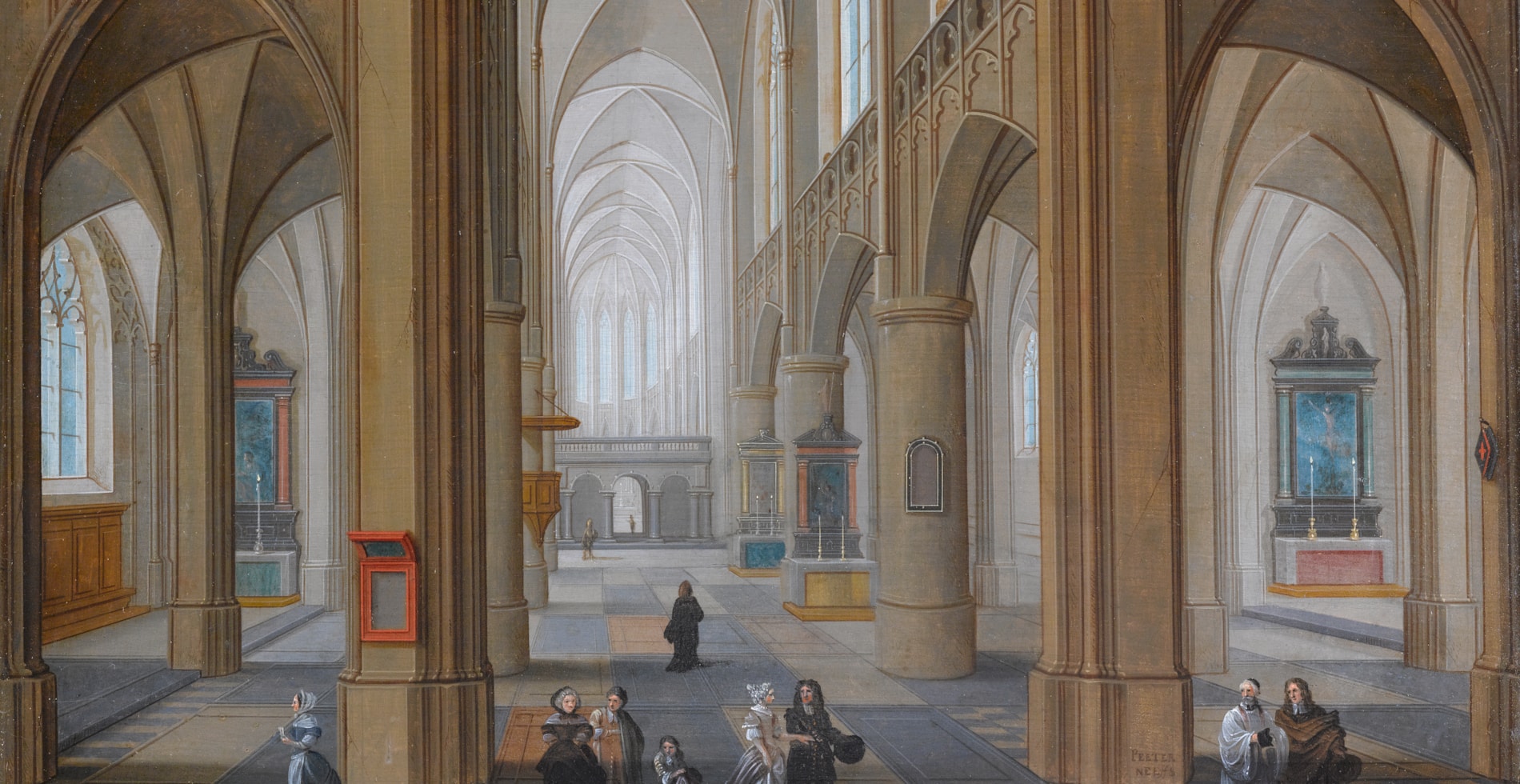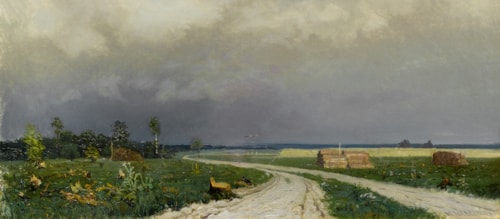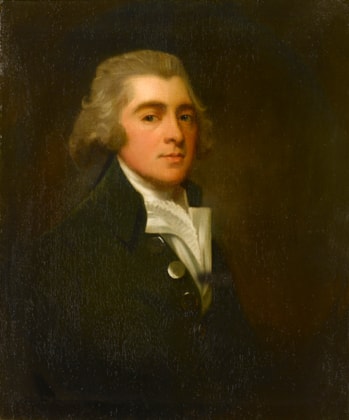ieter Neeffs The Elder
(Antwerp 1578 - Antwerp 1661)
The Interior of a Gothic Church with Elegant Company
signed ‘PEETER NEEFFS’ (lower right to the base of the column)
oil on panel
29 x 43 cm (11⅜ x 16⅞ in)
Pieter Neeffs the Elder specialised in views of church interiors, and the present painting is a typical example of his work. In the depiction of the cathedral’s interior, Neeffs has strived to convey the geometry and architectural rhythm of the building, as well as its grandeur and scale. The interior depicted here is likely to have been derived from The Cathedral of Our Lady in Antwerp, whose vast nave clearly served as inspiration throughout Neeffs’ career, although in Flemish architectural painting ‘actual church portraits are unusual – most of the interiors are imaginary views’.¹ Dwarfed by the Gothic grandeur, various members of Antwerp society mill about in the foreground. This serves not only as an artistic device to guide the eye and animate the scene, but it also reflects the central role religious buildings played in seventeenth-century daily life.
One of the outstanding features of Neeffs’ work is his handling of tonal variety. In the present work he delicately moves from light to shade, as the sun streams through the tall gothic windows, and plays off the monumental architecture. The sunlight of the present work has a genuine warmth to it, especially when contrasted with Antwerp Cathedral, in which the light feels harsher and colder, as if depicted on a winters day. Neeffs took this variation in his treatment of light further still, by often depicting nocturnes.
Neeffs was born in Antwerp, and was probably trained by either Hendrick van Steenwijk the Elder or Younger; the latter’s influence is particularly evident in Neeffs’ work. Van Steenwijk was a key figure in the development of architectural painting, and Neeffs and his son Pieter Neefs the Younger carried on the Steenwijk tradition in Antwerp.² Neeffs’ style is characterised by deeply receding spaces, created through the use of linear perspective and contrasting areas of light and dark, qualities very much in evidence in the present work.
¹ Rosenberg, J., Slive, S., & ter Kuile, E. H., Dutch Art and Architecture 1600-1800 (Penguin Books, Baltimore, 1966), p. 188.
² Ibid., p. 189.
Galerie Koetzer, Zurich;
West German Private Collection.
Pieter Neeffs the Elder specialised in views of church interiors, and the present painting is a typical example of his work. In the depiction of the cathedral’s interior, Neeffs has strived to convey the geometry and architectural rhythm of the building, as well as its grandeur and scale. The interior depicted here is likely to have been derived from The Cathedral of Our Lady in Antwerp, whose vast nave clearly served as inspiration throughout Neeffs’ career, although in Flemish architectural painting ‘actual church portraits are unusual – most of the interiors are imaginary views’.¹ Dwarfed by the Gothic grandeur, various members of Antwerp society mill about in the foreground. This serves not only as an artistic device to guide the eye and animate the scene, but it also reflects the central role religious buildings played in seventeenth-century daily life.
One of the outstanding features of Neeffs’ work is his handling of tonal variety. In the present work he delicately moves from light to shade, as the sun streams through the tall gothic windows, and plays off the monumental architecture. The sunlight of the present work has a genuine warmth to it, especially when contrasted with Antwerp Cathedral, in which the light feels harsher and colder, as if depicted on a winters day. Neeffs took this variation in his treatment of light further still, by often depicting nocturnes.
Neeffs was born in Antwerp, and was probably trained by either Hendrick van Steenwijk the Elder or Younger; the latter’s influence is particularly evident in Neeffs’ work. Van Steenwijk was a key figure in the development of architectural painting, and Neeffs and his son Pieter Neefs the Younger carried on the Steenwijk tradition in Antwerp.² Neeffs’ style is characterised by deeply receding spaces, created through the use of linear perspective and contrasting areas of light and dark, qualities very much in evidence in the present work.
¹ Rosenberg, J., Slive, S., & ter Kuile, E. H., Dutch Art and Architecture 1600-1800 (Penguin Books, Baltimore, 1966), p. 188.
² Ibid., p. 189.
Galerie Koetzer, Zurich;
West German Private Collection.





 contact
contact contact
contact +44 20 7313 8040
+44 20 7313 8040









